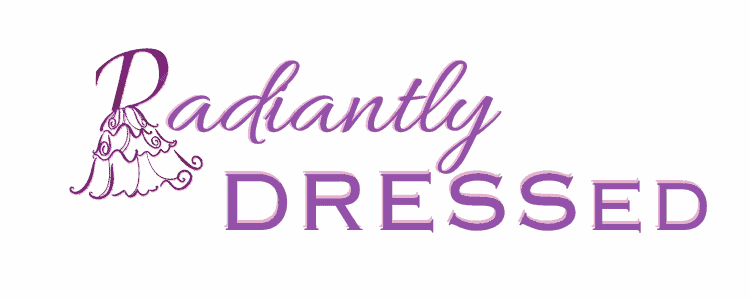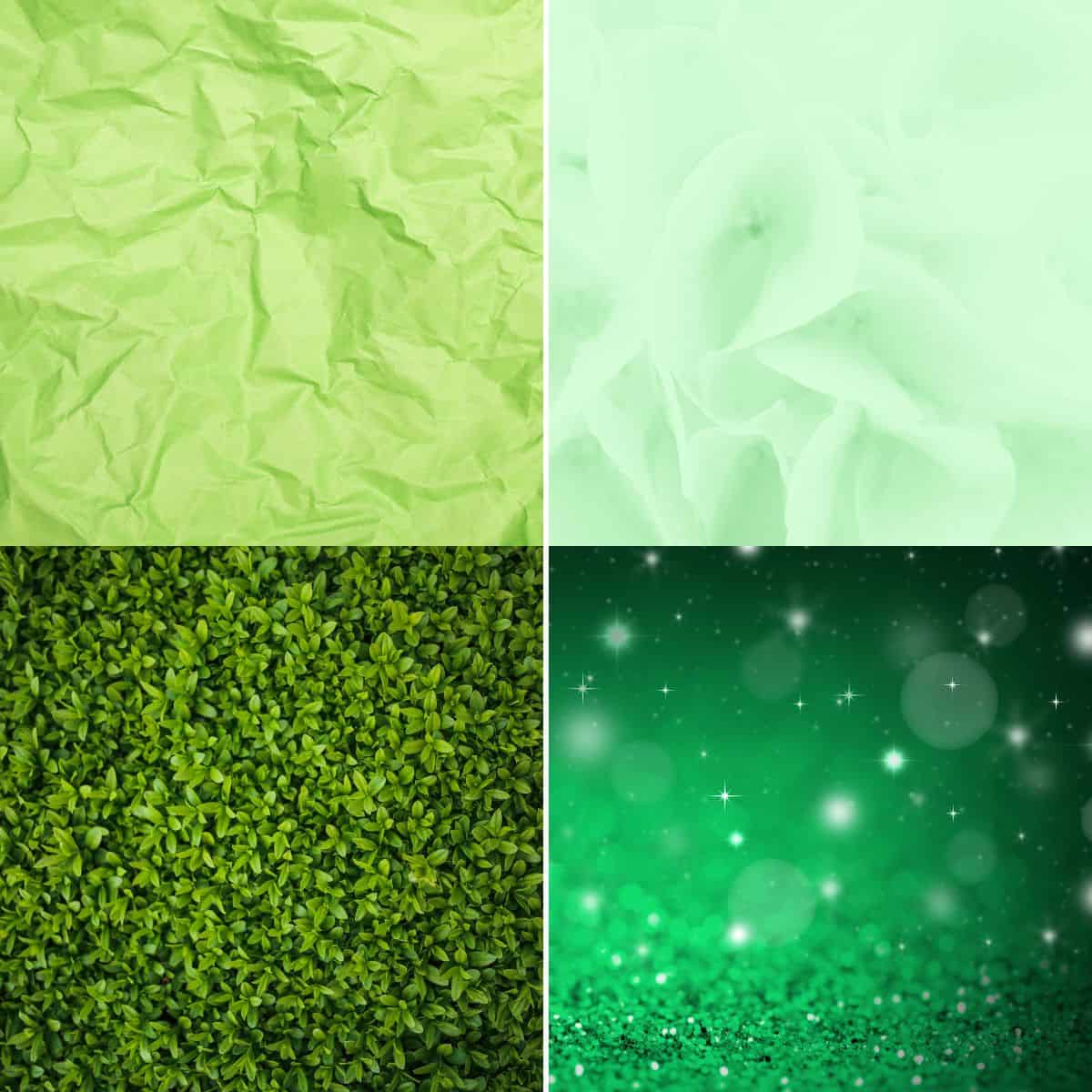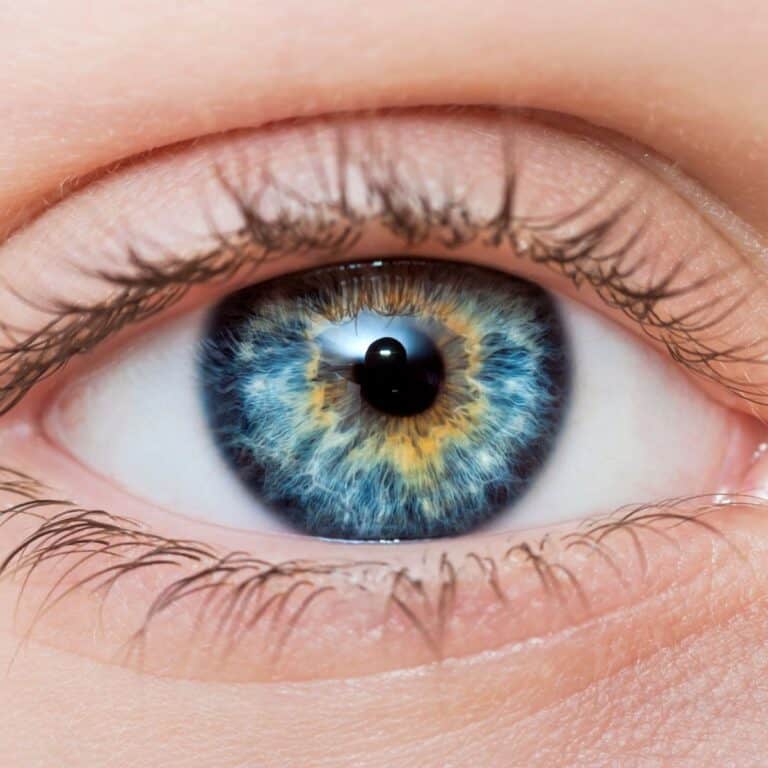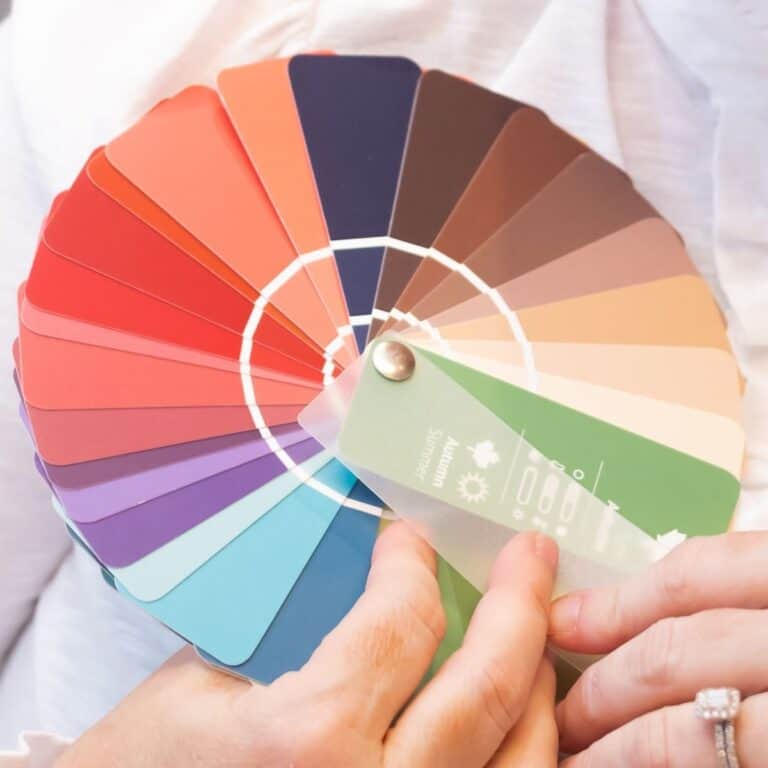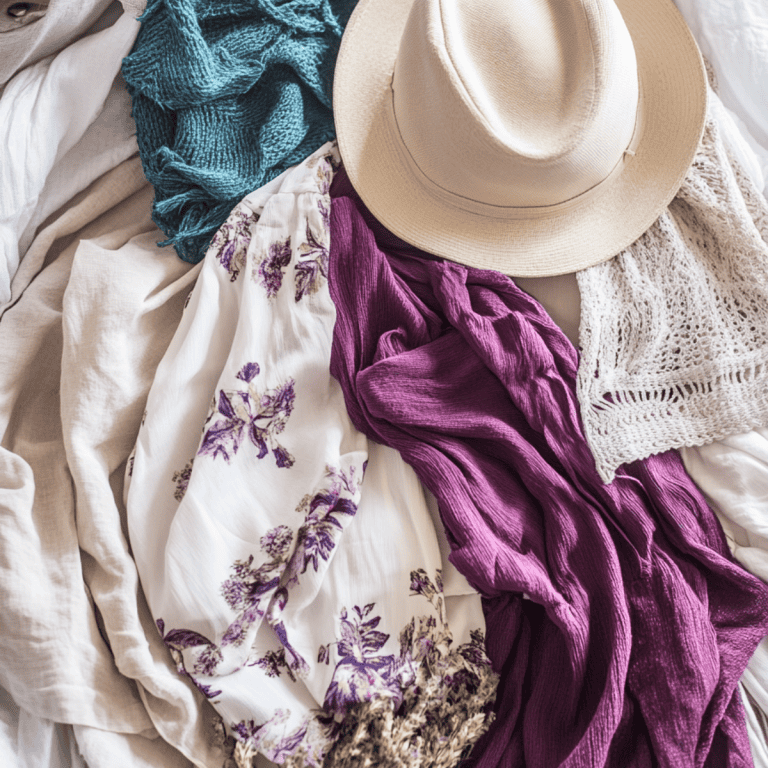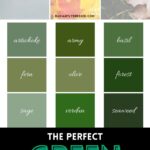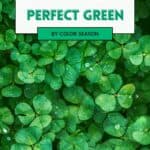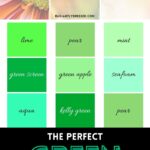Understanding your color season can transform how you wear green, ensuring you always look your best.
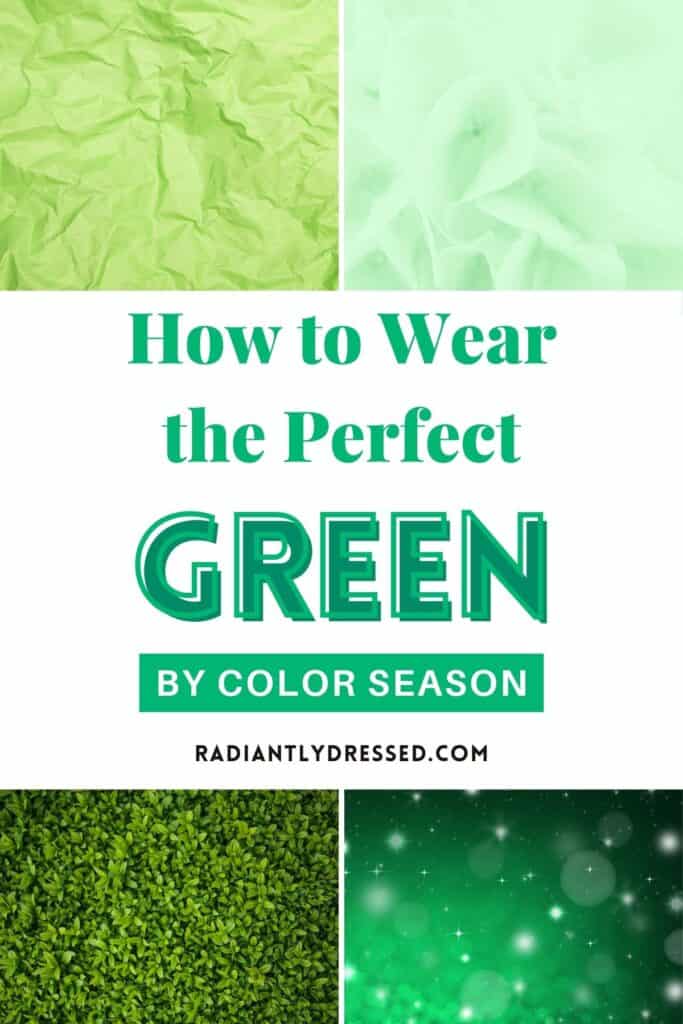
Understanding your personal color season can help you determine which colors harmonize best with your natural features such as skin undertones, eye color, and hair shade. Knowing your color season can guide you in choosing clothing and makeup that best enhances your appearance.
For those with a Spring color palette, opt for warm, vibrant greens to enhance your fresh and lively appearance. If you fall into the Summer category, gentle, cool greens will harmonize beautifully with your delicate, cool undertones. Autumns benefit from rich, earthy greens, which match their warm, deep hues. Winters look stunning in jewel-toned greens, which accentuate their striking contrasts and vibrant tones.
Discover how to incorporate green into your wardrobe and make it work for you in every season.
Table of Contents
The Psychology of Green
Green is a color associated with balance, harmony, and renewal. It plays a significant role both psychologically and in the fashion industry.
Green is widely regarded as the most restful and relaxing color for the human eye. It symbolizes growth, renewal, and abundance, mimicking the lush vegetation of nature. You often find green used in spaces designed to relax and rejuvenate, like spas or waiting rooms. This color can help reduce stress and create a sense of calm and tranquility. It is also thought to have a balancing effect on emotions, promoting a sense of peace and equilibrium.
In fashion, green is versatile and comes in a variety of shades from soft mint to deep emerald. It is often used to signify freshness and vitality. You’ll see green in spring and summer collections for its associations with new beginnings and growth. Darker greens like olive or forest green are popular in fall and winter for their rich, earthy tones. Green accessories, such as handbags or scarves, can add a pop of color to neutral outfits, making them more vibrant and eye-catching.
Explore the psychology of green, and let it enliven up your fashion choices.
Understanding Color Seasons
Color seasons are a concept in fashion and beauty that relates to finding the colors that best match your natural features like skin tone, hair color, and eye color. There are 4 major seasons that split into 3 smaller sub-seasons each:
- Spring – warm and light with bright contrast: clear spring, warm spring, light spring.
- Summer – cool and light and muted: light summer, cool summer, soft summer.
- Autumn – warm and dark with low contrast: soft autumn, warm autumn, deep autumn.
- Winter – cool and dark with high contrast: deep winter, cool winter, clear winter.
Here’s a quick way to get started in identifying your season:
- Observe your natural skin tone, eye, and hair color.
- Compare these to the typical characteristics of the four seasons.
- Notice how certain colors impact your appearance—do they make you look vibrant or washed out?
Want to find your season? Grab the DIY color analysis course today and find your best colors.
Tired of going round in circles trying to figure out your color season? Hack the same process used by professional color analysts to figure out your season from the comfort of your home, and stop feeling confused about color analysis with Personal Prism.
Now that you know a little more about color seasons, you’re on your way to choosing shades of green that make you look your best!
The Perfect Green for Spring Seasons
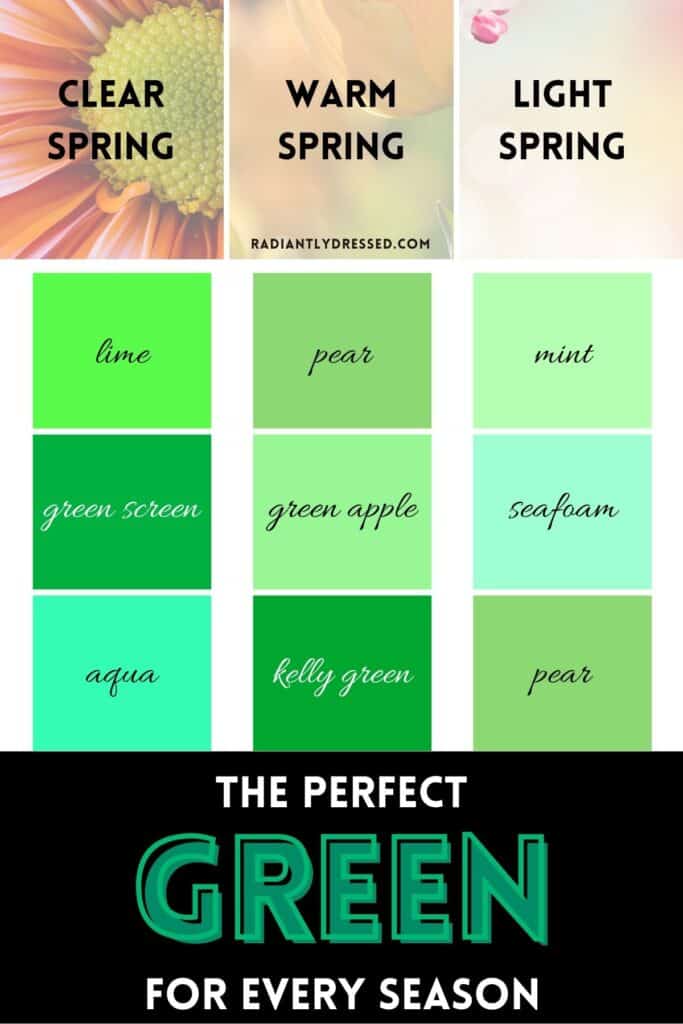
The three spring seasons are warm in undertone, overall light in value, and bright in chroma or saturation. The greens for these seasons need to have those same characteristics. There is some crossover in the greens that work, but slight adjustments can be made for changes in saturation and value.
For clear spring, consider bold, bright, greens such as lime, green screen, and aqua
For warm spring, stick with bright warm greens like pear, green apple, and kelly green.
Light spring needs slightly lighter versions of green, such as mint, seafoam, and pear.
The Perfect Green for Summer Seasons
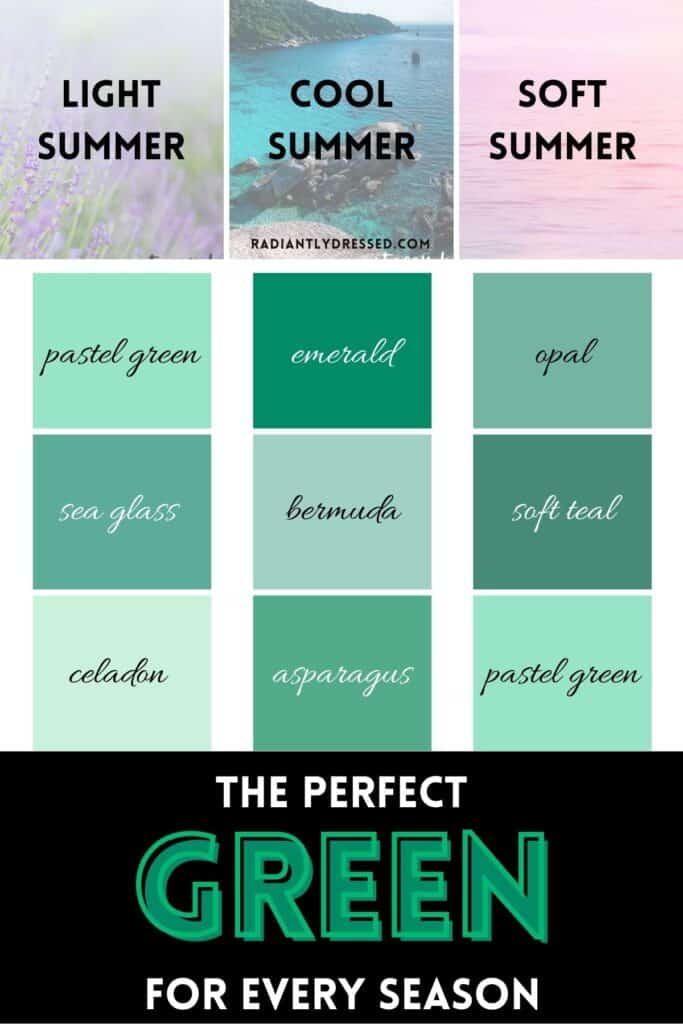
The three summer seasons are cool in undertone, overall light in value, and muted in chroma, not very saturated. Choosing greens with those same characteristics will create a harmonious appearance. These greens will work for all 3 summer seasons, but reflect the variations in intensity and depth.
Light summer will do best in the most pastel versions of green such as pastel green, seaglass, and celadon.
Cool summer steals a bit of brightness from its sister season of winter and can wear shades like emerald, bermuda, and asparagus.
Soft summer sticks with muted greens such as opal, soft teal, and pastel green.
The Perfect Green for Autumn Seasons
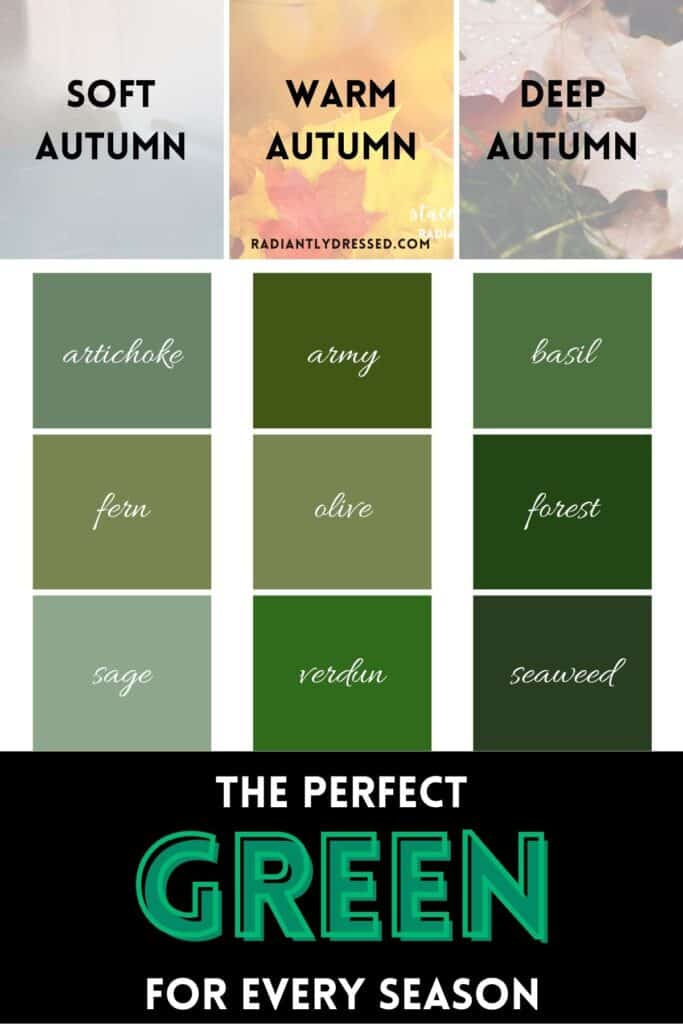
Autumn types are warm in undertone, overall dark in value, and muted in chroma, with a bit of muddiness to the colors. The three autumn seasons should choose greens that mimic the soft characteristics of this type. You can always borrow from your sister seasons, but the greens for each subseason show slight variations for chroma and value.
For soft autumn, consider muted greens like artichoke, fern, and sage.
Warm autumn gets a bit of a brightness boost, and greens such as army, olive, and verdun work well.
Deep autumn is one of the darkest seasons and should stick to shades of green like basil, forest, and seaweed.
The Perfect Green for Winter Seasons
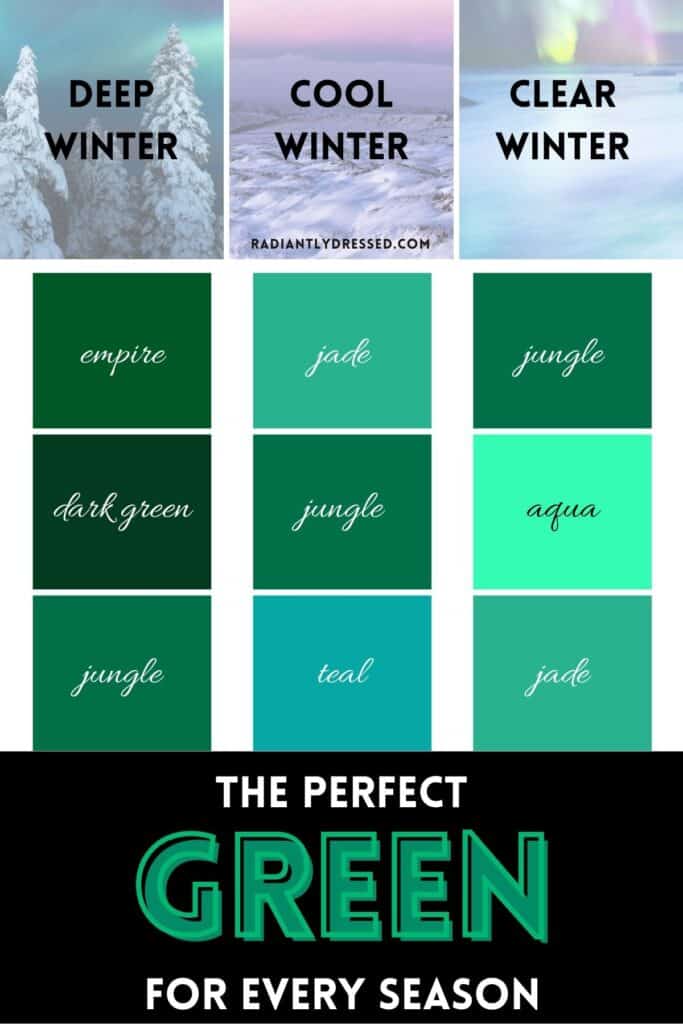
The three winter seasons are cool in undertone, darker in value, and exhibit a high degree of contrast or saturation. The green for this season are bright, blue based shades. The range can be worn by all winters, so choose based on your level of brightness or depth.
Deep winter needs dark greens such as empire, dark green, and jungle.
Cool winter needs the bold true greens like jade, jungle, and teal.
For clear winter, choose the brightest versions of cool green such as jungle, aqua, and jade.
Green Styling Tips
Mixing Patterns and Textures
Incorporating green into your wardrobe through patterns and textures can bring a refreshing and stylish flair to your outfits. Green floral prints on flowy fabrics like chiffon or cotton add a touch of nature-inspired elegance. Stripes or polka dots in green shades create lively, playful looks that are perfect for any season.
Experiment with textures by pairing a soft green knit sweater with rugged denim jeans or a silk blouse with a tweed skirt. Mixing different textures not only adds visual interest but also keeps your attire sophisticated and engaging. Green accessories, such as scarves, handbags, or shoes, can seamlessly tie your outfit together while adding a pop of color.
Layering with Green
Layering is a versatile way to incorporate green into your ensembles. Start with a deep forest green turtleneck or cardigan as a foundational piece. Pair it with a neutral trench coat or a leather jacket to create a balanced and stylish look.
You can also layer using lighter shades of green. A mint green blouse under a grey blazer adds a soft, refreshing touch. Don’t be afraid to mix and match textures, such as a woolen green scarf with a satin top, to create depth and dimension in your outfit.
Green as an Accent Color
If wearing green as the main color seems too bold, using it as an accent can be a great alternative. Accessories like scarves, belts, or gloves in vibrant green hues can add a lively touch to your look without being overpowering. Imagine a jade green scarf against a navy coat or emerald green gloves with a black sweater.
Jewelry is another subtle way to introduce green. Pieces with green gemstones or beads, like earrings or necklaces, can complement your outfit and bring a touch of nature’s beauty close to your face.
Green Accessories
Green accessories offer an easy way to infuse this color into your outfits without overwhelming your style. Think chic green handbags, sunglasses, or even nail polish. These small touches can make a big impact and are easily interchangeable.
For a more understated effect, consider green belts, scarves, or hats. A green belt can add a splash of color to a monochrome dress, while a green hat or scarf can refresh classic neutral outfits with a seasonal twist.
Mixing and matching green accessories with different outfit combinations keeps your style vibrant and dynamic. For example, pairing a green tote bag with a white summer dress or denim and a light blouse can instantly elevate your look.
Accessorizing with Green
- Jewel-Toned Elegance: Rich jewel tones like emerald, jade, and teal bring a touch of luxury and sophistication to any outfit. Emerald earrings or jade necklaces can serve as striking focal points, enhancing both casual and formal looks. A teal clutch adds a vibrant pop of color, perfect for elevating monochrome or neutral ensembles.
- Playful Pops of Color: Bright shades like lime and chartreuse add a fun and lively element to your wardrobe. Lime green shoes can transform simple outfits into standout ensembles, while a chartreuse belt injects vibrancy and highlights your silhouette. A neon green bag is a bold choice that showcases your adventurous spirit and energizes your look.
- Natural and Earthy Vibes: Earthy greens like olive, moss, and sage create a grounded and harmonious style. An olive scarf adds warmth and texture to neutral outfits, while a moss green hat offers earthy sophistication. Delicate sage green jewelry provides a soft, calming touch, perfect for enhancing everyday wear.
- Mixing and Matching Green Accessories: Combining different shades of green can create a cohesive yet dynamic look. Layering green jewelry or choosing gradient-effect bags adds dimension and interest to your ensemble. Coordinating green footwear and headwear in varying shades brings a harmonious yet varied appearance to your outfit.
- Green for Bold Statements: Make a strong impression with bold green accessories that draw attention. Large, chunky green necklaces or oversized earrings can become the focal point of your outfit, adding drama and flair. Distinctive green boots or heels elevate your style, turning heads and showcasing your confident fashion sense.
Remember, accessorizing is a personal choice and should reflect your unique style. Experiment with different combinations to find what makes you feel confident and fabulous.
Perfect green Color Pairings
Green is a versatile color that complements every season beautifully. Whether it’s spring’s fresh pastels, summer’s vibrant hues, autumn’s earthy tones, or winter’s cool contrasts, there’s a perfect green pairing for every time of year.
Spring
- Green and Blush Pink: Fresh and delicate.
- Green and Sky Blue: Soft and serene.
- Green and Coral: Vibrant and lively.
Summer
- Green and White: Crisp and clean.
- Green and Yellow: Bright and cheerful.
- Green and Turquoise: Fun and tropical.
Autumn
- Green and Rust Orange: Deep and earthy.
- Green and Mustard Yellow: Warm and inviting.
- Green and Burgundy: Luxurious and deep.
Winter
- Green and Black: Bold and striking.
- Green and Navy: Classic and sophisticated.
- Green and Silver: Crisp and festive.
When choosing the right combinations, consider the shades and undertones of the colors you are pairing. Experiment with different options to find what makes you feel confident and stylish in every season.
Care and Maintenance of Green Garments
Proper care and maintenance of green garments can help maintain their vibrant color and extend their lifespan. Different materials and shades of green might require specific care routines to ensure they remain in pristine condition.
Washing Tips
- Cold Water Washing: Wash your green garments in cold water to help retain color and reduce carbon emissions.
- Gentle Soap Flakes: Use gentle soap flakes instead of harsh detergents to prevent color fading.
- Inside-Out Washing: Turn garments inside-out before washing to protect the exterior from wear.
Drying Methods
- Air Drying: Hang your clothes to dry instead of using a dryer to save energy and avoid heat damage.
- Dryer Balls: If you use a dryer, include dryer balls to reduce drying time and static.
Ironing and Wrinkle Removal
- Steam Ironing: Use a steam iron on a low setting for wrinkle removal.
- Shower Steam: Hang garments in a steamy bathroom to relax the fibers and remove wrinkles without ironing.
Stain Removal
- Spot Treatment: Treat stains promptly with mild, eco-friendly stain removers.
- Avoid Chlorine Bleach: Use oxygen-based bleach for tough stains instead of chlorine bleach, which can fade colors.
By following these simple care and maintenance tips, your green garments will look fresh and last longer, making your wardrobe more sustainable.
Incorporating Green for Work
Green is a versatile color that can bring a fresh, confident vibe to your professional wardrobe. Whether you prefer bold statements or subtle accents, there are many ways to integrate green into your work outfits while maintaining a polished and professional appearance.
Green as a Statement Piece
Make a bold impact with green by choosing it as the main focus of your outfit. A green blazer or jacket in shades like emerald, forest green, or olive can elevate your look, adding a touch of authority and style. Pair these with neutral basics such as black, white, or beige to balance the vividness and create a refined ensemble. Green dresses or skirts also work wonderfully as statement pieces, offering a sophisticated yet vibrant option for your office wear.
Subtle Green Accents
If you prefer a more understated approach, use green as an accent color through accessories. Green scarves, belts, or handbags can add a pop of color to your outfit without being overwhelming. Opt for forest green handbags or jade belts to subtly enhance your look. Additionally, green jewelry like earrings, necklaces, or bracelets can introduce just the right amount of color, perfect for adding a hint of sophistication to your attire.
Green in Prints and Patterns
Incorporating green through prints and patterns is a stylish way to add personality to your workwear. Blouses and tops with green floral, geometric, or abstract patterns can bring vibrancy and interest to your professional wardrobe. Pair these patterned pieces with solid-colored trousers or skirts to keep your look balanced and cohesive. Green-printed scarves can also add a layer of elegance and texture, perfect for a chic office appearance.
Green Bottoms
Green trousers or skirts offer a fresh alternative to traditional office colors. Dark green trousers can provide a sleek and modern look when paired with neutral blouses or blazers. Similarly, a green pencil or A-line skirt adds a dynamic and feminine touch to your professional ensemble. Opt for shades like olive or pine green for a versatile and stylish addition to your work wardrobe.
Layering with Green
Layering is a great way to incorporate green into your professional outfits, especially during transitional weather. Green cardigans or sweaters can be worn over blouses or under blazers, adding warmth and a subtle pop of color. Light greens like mint or sage are ideal for spring, while darker greens like moss or hunter green are perfect for cooler months. A structured green blazer can also serve as a sophisticated layer, offering a sharp and modern edge to your look.
Footwear with a Hint of Green
Integrate green into your footwear for a subtle yet impactful addition to your professional attire. Green shoes, such as pumps, loafers, or flats, can complement your outfit beautifully, adding a touch of sophistication and personality. Opt for deep green or olive shoes for a classic and understated look, or choose brighter greens like teal or mint for a bit more flair. In cooler weather, green boots can be a stylish option, pairing well with dresses, skirts, or trousers.
Combining Green with Neutrals
Green pairs exceptionally well with neutral colors, making it easy to integrate into your professional wardrobe. Combine green with black, white, grey, or beige for a balanced and harmonious look. For instance, a green blouse with a black skirt or grey pants creates a sophisticated and professional appearance. A crisp white shirt with a green skirt or trousers offers a fresh and clean look, perfect for maintaining a bright and polished presence in the office.
Balancing Boldness and Subtlety
Find the perfect balance between bold and subtle with your use of green. For a more daring approach, try color blocking by pairing green with other solid colors like navy or beige. This creates a bold yet harmonious outfit that stands out while remaining professional. Alternatively, if you prefer a more understated look, choose muted shades of green such as sage or olive. These colors provide a calming and professional presence without drawing too much attention.
By thoughtfully integrating green into your professional attire, you can bring a fresh and dynamic touch to your work wardrobe. Whether through bold statement pieces or subtle accents, green offers a versatile and stylish option for expressing your personality while maintaining a polished and professional look in the office.
Frequently Asked Questions about How to Wear Green
What are the main color seasons and how do they influence the best shades of green to wear?
The main color seasons are Spring, Summer, Autumn, and Winter. Each season has specific color palettes that complement the natural tones of your skin, hair, and eyes. Understanding your color season helps in choosing the most flattering shades of green for your wardrobe.
How can I incorporate green into my wardrobe if I’m not used to wearing it?
Start by introducing green through accessories like scarves, bags, or jewelry. You can also try layering green pieces with your existing neutral wardrobe staples to gradually integrate the color into your outfits.
Can I mix different shades of green in one outfit?
Yes, mixing different shades of green can create a cohesive and dynamic look. Aim for varying tones and textures to add depth and interest. For example, pair a dark green jacket with a lighter green blouse or a mint green skirt with olive accessories.
How do I know which shade of green suits my skin tone?
Generally, warm skin tones are complemented by warm greens (like olive or lime), while cool skin tones are flattered by cool greens (like mint or sage). Conducting a color analysis can provide more personalized recommendations based on your overall coloring.
Can I wear green year-round, or is it better suited for specific seasons?
Green is a versatile color that can be worn year-round. In spring and summer, lighter and brighter greens are perfect, while in autumn and winter, deeper and more muted greens are ideal. Adjust the shade and fabric weight of green pieces to suit the season.
How can I confidently wear green if it’s outside my usual color comfort zone?
Start with smaller green items or accents and gradually introduce larger pieces as you become more comfortable. Experiment with different shades and styles to find what resonates with you. Remember, confidence comes from feeling good in what you wear, so choose greens that make you feel vibrant and self-assured.
Related Color Analysis Articles:
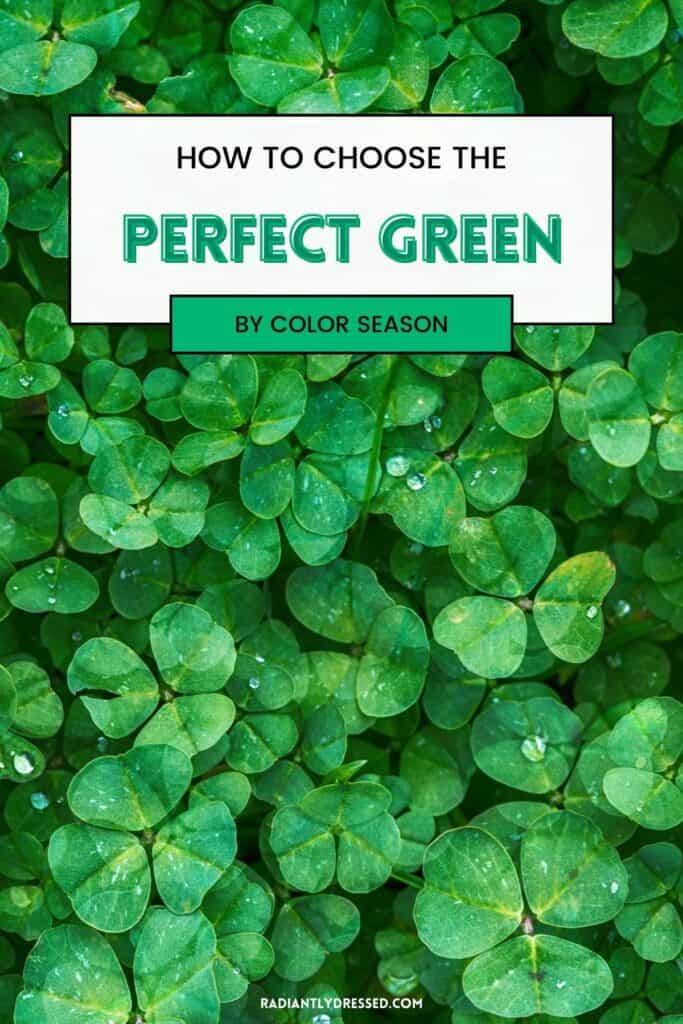
Selecting the right shade of green makes all the difference, enhancing your natural beauty and boosting your confidence.
Stacey is the owner and creator behind Radiantly Dressed. She is a certified image consultant and AICI member focusing on creating simplicity in wardrobes via color and style.

